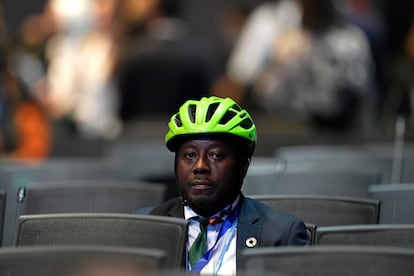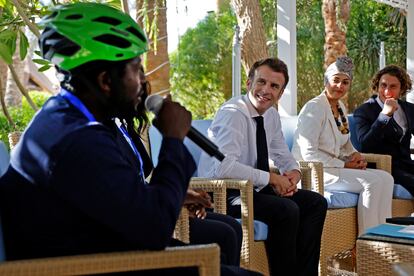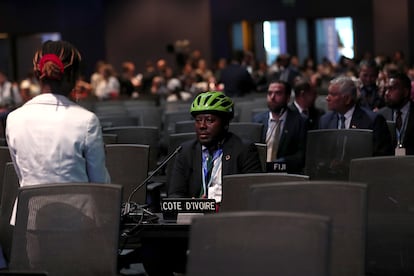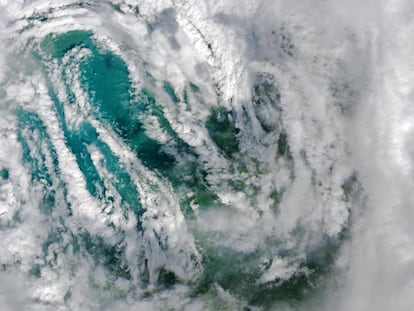Who is the man wearing a bike helmet around COP27?
Ivorian activist Andy Costa has become one of the most photographed participants at the UN climate summit, always donning his neon green headgear


A bright green bicycle helmet stands out among the crowds that walk around the miles of pavilions of COP27, the UN climate summit. Since the beginning of the conference, it has become one of the main protagonists of Sharm el-Sheikh – as photographed as the political leaders who are gathered in Egypt for the event. But who is the person in a bike helmet who sits at the tables of the delegations and chats with heads of state such as French President Emmanuel Macron? “Hello! How are you?” greets Ivorian activist Andy Costa with a big hug. He is a brawny and affable man, who for the occasion complemented his look with a light blue African tunic, although he also usually wears a suit and tie.
The reasoning behind his bright green helmet is simple: it is impossible to pass unnoticed. That is why he even wears it in his WhatsApp profile picture. It is his personal brand, explains Costa, who is a member of the My Dream for Africa Foundation. “On the one hand, I promote bicycle mobility, but on the other, the helmet is an object of protection and symbolizes how we must protect the environment,” he says.
As a result of all the attention his helmet has attracted, Costa has earned a reputation as Africa’s cycling ambassador, an essential role in a continent that is gradually incorporating highways into its layout, but which lacks an extensive railway network and has serious traffic problems, countless roads in poor condition and remote areas that are difficult to access or dangerous. In this context, Costa proposes using the bicycle. First of all, for the environment; secondly, to avoid traffic collapses in the cities, and thirdly, for health. It is a great way to avoid cardiovascular disease, which is a public health problem, he points out.

The Ivorian is clear about the way he would implement the bicycle in a content with poor infrastructure, where this form of transport is rarely used. “You have to start with university students, as they are the future climate leaders,” he says. “If it is an active means of mobility for them, they will make it a priority.”
“Next, the private sector must be involved in the fight against climate change. This can be done through sponsorships or social responsibility projects. They already have one to support its use in rural areas and among girls, who are frequently forced to abandon school due to the long distances they have to travel while being vulnerable and more susceptible to danger,” he points out. The third approach is political involvement. According to his reasoning, in addition to including cycling infrastructures in urban design, authorities should reduce the taxes on bicycle distribution chains to make them more affordable, and it should create laws to protect cyclists.
His tools are social media and meetings with companies and politicians at different levels – just like the one he had with Macron at a meeting of young Africans. Besides talking about mobility on the continent, Costa asked the French president to review the geographic mobility policies, so that people can move more easily and share experiences and training.

Costa also faces another obstacle: sometimes, local populations link the use of bicycles to people with limited resources, which creates a stigma and resistance. “In Africa, the bicycle does not have the same image it does in the West. That’s why our first mission is to give it visibility,” he explains. To do this, in addition to sharing images with politicians, he has reached out to celebrities who pose with him wearing the helmet, such as the singer Asalfo from the popular group Magic System or the Ivorian soccer player Didier Drogba. “We have to change the image, we have to change it.” This seems to be his mantra in COP27, his sixth time attending the conference.
In Africa, the bicycle is also a viable alternative for short trips, given how difficult it is to pay for private vehicles, fuel and energy in a continent that barely emits 4% of carbon dioxide gases. It’s a situation that has both governments and companies on the lookout for ways to redesign mobility. According to African Transport Policy Program, “despite being the least motorized region, [Africa] has the highest road traffic fatality rates in the world: 2.6 per 100,000 people. This translates to 650 deaths per day, nearly half of which involve vulnerable road users such as pedestrians, cyclists and motorcyclists.”
The global trend points to 60% of the world’s population living in urban areas by 2030. Africa is advancing towards those numbers, which hide the depopulation of rural areas, and the resulting loss of infrastructure and opportunities in those places. Droughts, erratic rains, soil degradation and the extreme heat provoked by climate change are displacing the population and making it difficult to work in key sectors, such as agriculture, which provides 75% of the population depends on, be it through direct or indirect jobs. For Costa, his neon green helmet is at the epicenter of the change, inspired by a quote by Albert Einstein: “Life is like riding a bicycle. To keep your balance, you must keep moving.”
Tu suscripción se está usando en otro dispositivo
¿Quieres añadir otro usuario a tu suscripción?
Si continúas leyendo en este dispositivo, no se podrá leer en el otro.
FlechaTu suscripción se está usando en otro dispositivo y solo puedes acceder a EL PAÍS desde un dispositivo a la vez.
Si quieres compartir tu cuenta, cambia tu suscripción a la modalidad Premium, así podrás añadir otro usuario. Cada uno accederá con su propia cuenta de email, lo que os permitirá personalizar vuestra experiencia en EL PAÍS.
¿Tienes una suscripción de empresa? Accede aquí para contratar más cuentas.
En el caso de no saber quién está usando tu cuenta, te recomendamos cambiar tu contraseña aquí.
Si decides continuar compartiendo tu cuenta, este mensaje se mostrará en tu dispositivo y en el de la otra persona que está usando tu cuenta de forma indefinida, afectando a tu experiencia de lectura. Puedes consultar aquí los términos y condiciones de la suscripción digital.
More information
Archived In
Últimas noticias
Most viewed
- Alain Aspect, Nobel laureate in physics: ‘Einstein was so smart that he would have had to recognize quantum entanglement’
- Mexico’s missing people crisis casts a shadow over World Cup venue
- Why oil has been at the center of Venezuela-US conflicts for decades
- Trump clarifies who is ultimately in charge in Venezuela: ‘Me’
- Mexico seeks to shore up its defenses following US incursion in Venezuela










































